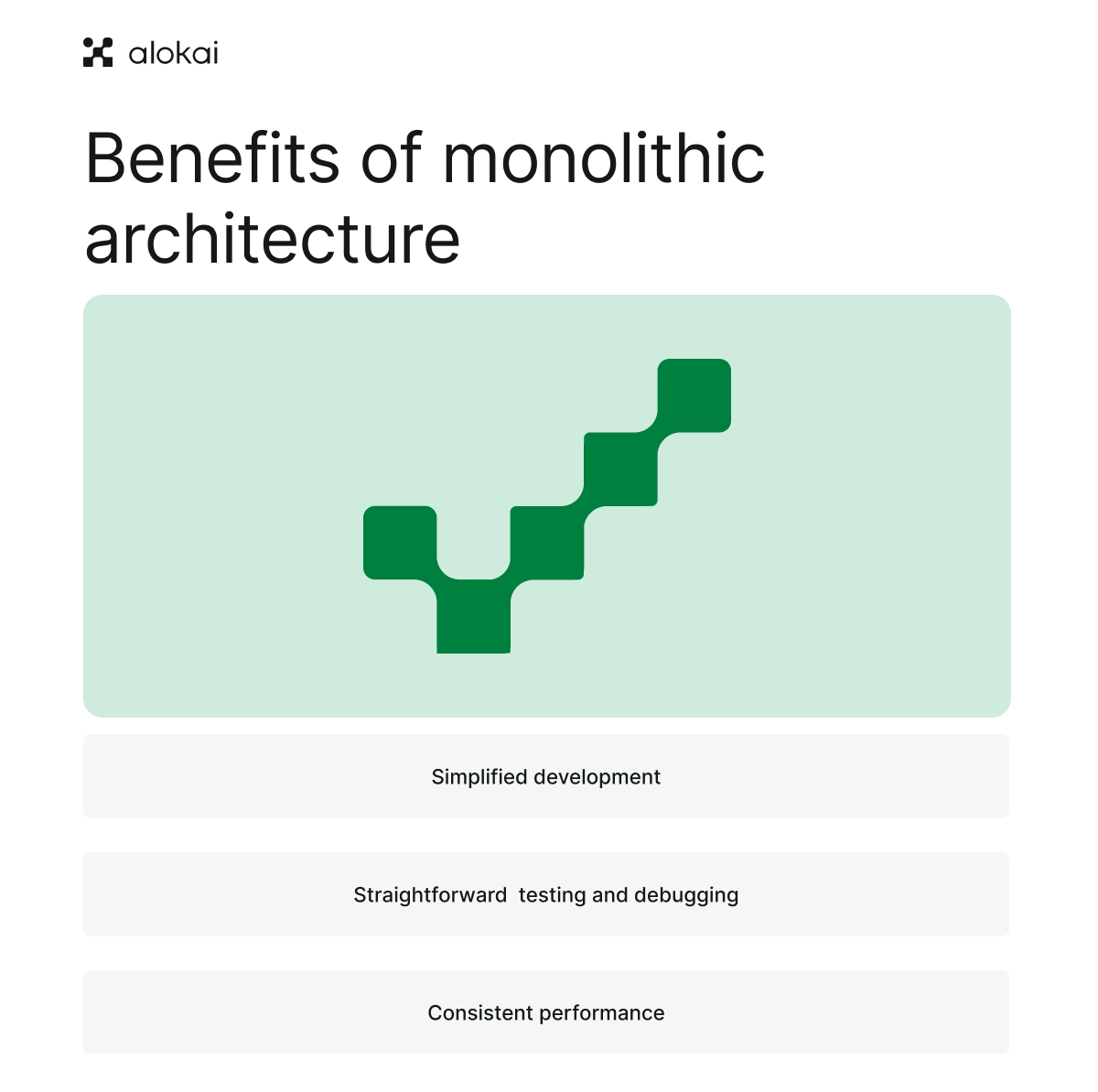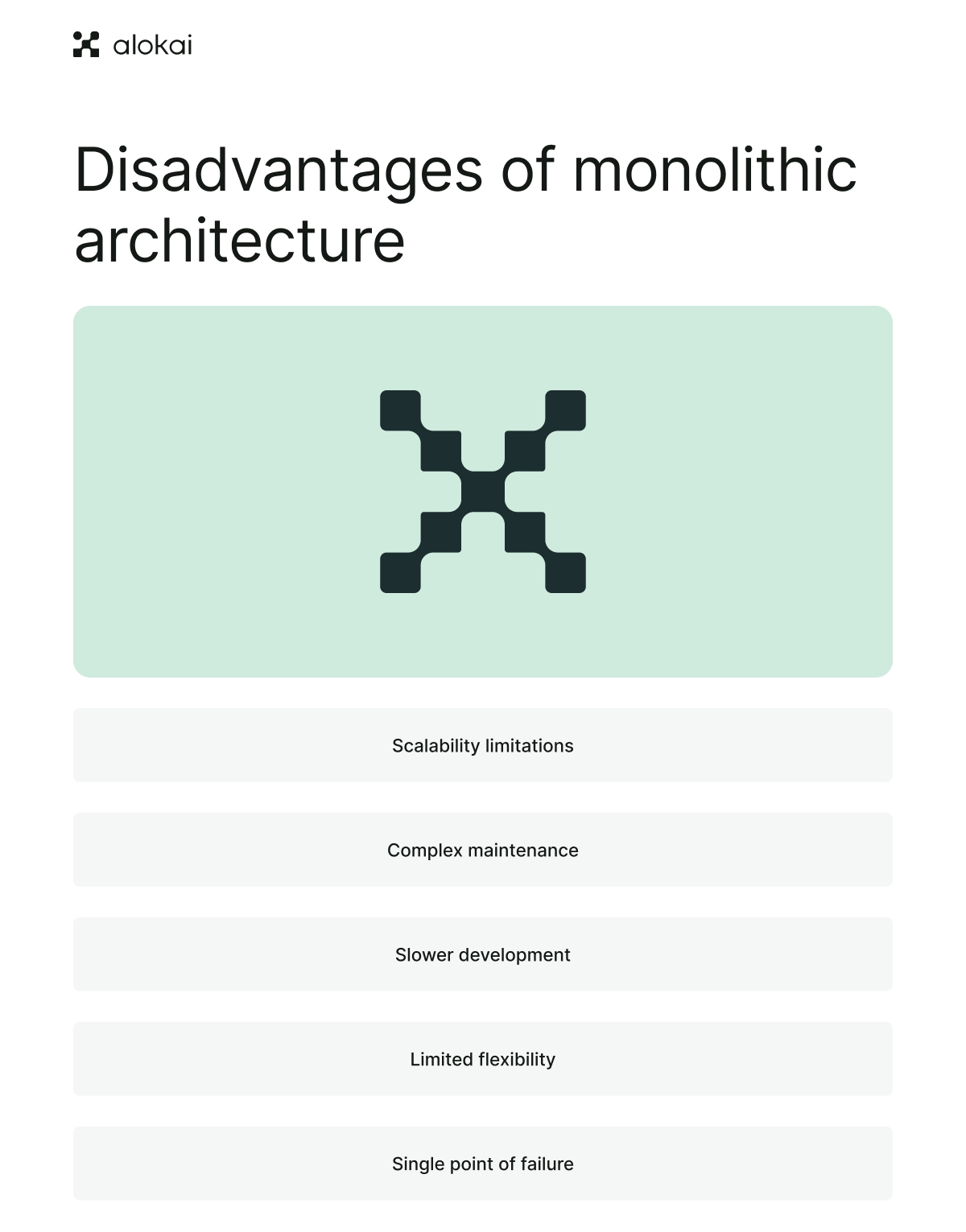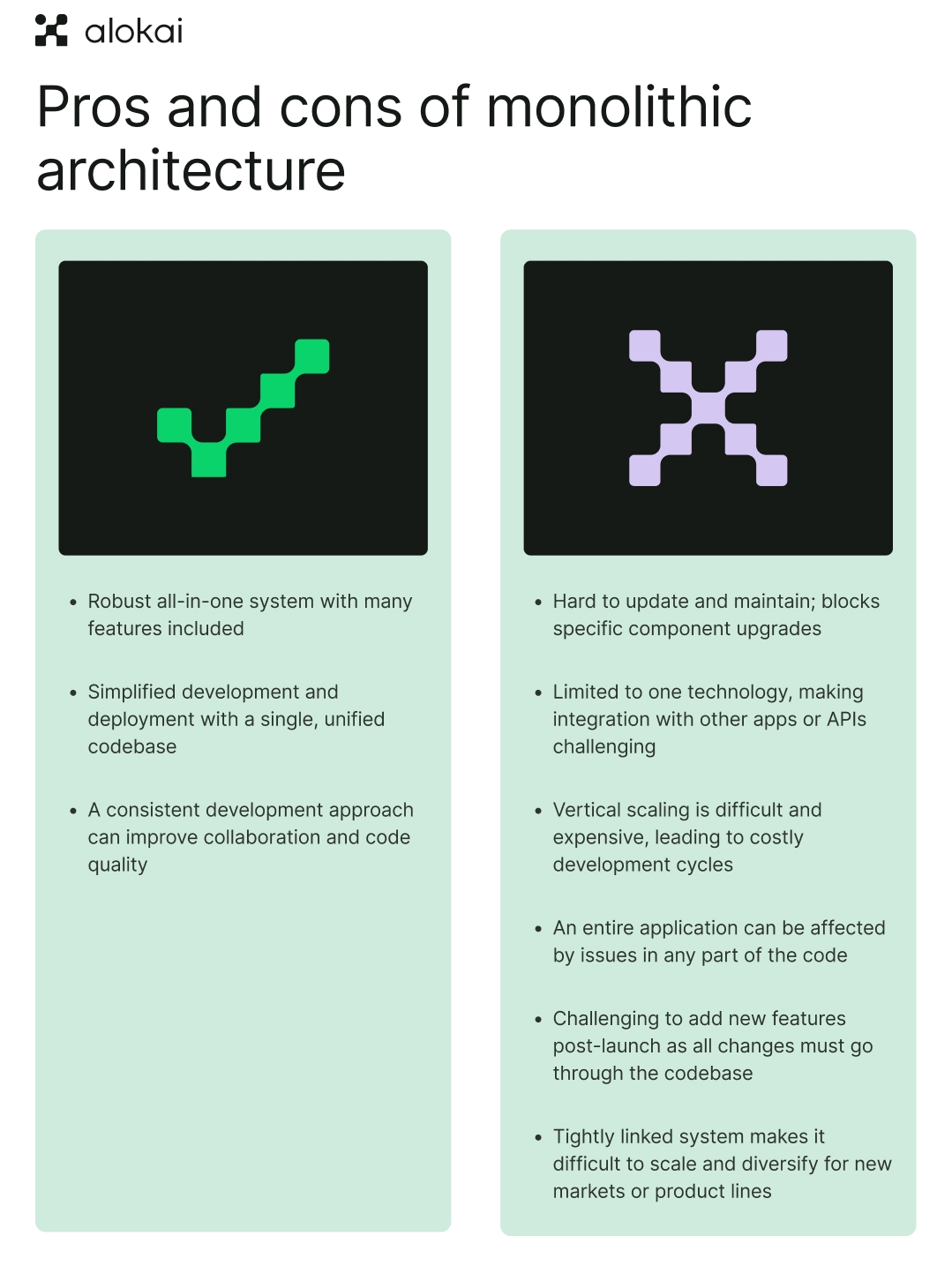Monolith architecture integrates every aspect of a software application into a single, powerful framework. Perfect for specific scenarios, it offers a streamlined approach but can also present challenges, especially when it comes to scaling and maintenance.
In this article, we’ll dive into the basics of monolithic architecture, highlight the standout advantages, and help you determine when to choose monolith, and when to opt for an alternative.
What is a monolithic application?
A monolithic application is an all-in-one system that covers multiple ecommerce features under one hood.
In monolith applications, the frontend and backend are linked together in a coupled architecture where all components depend on each other. This means that within the monolithic approach, when you want to update one element on the frontend side, it requires changes to the entire ecommerce application.
Why do companies choose monolithic architecture?
Monolithic systems are praised for their simplicity, as everything is bundled into one unified codebase. This makes them easier to understand, manage, and oversee compared to more complex, distributed systems.
But that simplicity can also become a problem. Because all the components are tightly connected, scaling becomes a challenge – boosting one part means scaling the whole system, which can eat up time and resources.
Even with these hurdles, monolithic systems still shine when it comes to performance. The tightly integrated design allows for quick communication and efficient processing, keeping everything running smoothly.
Benefits of monolithic architecture
There are several advantages to adopting a monolithic architecture, particularly for companies looking for simplicity and ease of management, and ones that don’t need to scale fast.

1. Simplified development process
With all components in one codebase, developers can work on different parts of the application without needing to navigate between multiple repositories or services. This can make development easier to manage, especially for teams that are familiar with the codebase.
2. Straightforward testing and debugging
Testing a monolithic application is often simpler because everything is contained within a single environment. You can test the entire application as a whole, without needing to mock or simulate interactions between different services. Similarly, debugging is also straightforward since you’re working within a single codebase.
3. Consistent performance
Because all components run within the same process, monolithic applications can deliver consistent performance. Since everything is tightly knit into one system, there’s no need to worry about network latency or communication overhead between different services.
Drawbacks of monolithic architecture
While monolith architecture has its advantages, there's a reason why companies have been shifting more toward composable commerce in recent years. Below you will find some of the key issues with traditional legacy solutions.

1. Scalability limitations
This is the most glaring con of monolithic architecture and one of the main reasons why this approach is becoming a bit of a thing of the past.
Monolithic applications are difficult to scale efficiently because all components are tightly interconnected. The tightly knit and complex nature of its components means that scaling up often requires boosting compute resources across the entire system, even if only one specific part actually needs the extra power. This can lead to a host of inefficiencies, including sluggish deployments, poor resource allocation, and expensive vertical scaling.
However, this challenge can be navigated. You can:
Enable decoupling
Implement horizontal scaling through multiple instances of the application
Gradually migrate tomicroservices architecture
2. Complexity in maintenance
As a monolithic application grows, its codebase can become increasingly complex and harder to manage.
Needless to say, this complexity can make maintenance a real headache. Even a minor change in one part of the system can have unexpected consequences elsewhere, leading to longer development cycles, more bugs, and a greater risk of introducing errors during updates.
If the app becomes too bloated and the performance begins to suffer, this can also affect your SEO results. Since the 2021 update, Google has used page and image loading times as one of the core ranking elements for websites. With the monolithic model, it's difficult to introduce changes vital for matching Google's requirements.
3. Slower development
With monolithic architecture, every time you want to introduce a new feature or update, you have to redeploy the entire application. This can slow down the development process significantly, as you’ll need longer build times and testing. The result is a bottleneck in deployment that can delay getting new features and fixes into the hands of users.
4. Limited flexibility
Legacy monolithic software is often rigid and difficult to adapt. If you want to incorporate new technologies or frameworks, it typically requires significant refactoring of the entire application. This lack of flexibility can hinder innovation, making it more challenging to evolve your application or adopt modern development practices.
5. Single point of failure
While the tight coupling of components means a consistent performance, it’s a double-edged sword. Because it’s all in one system, a failure in one part of a monolithic application can bring down the entire system. This creates a single point of failure that can lead to significant downtime and makes it harder to ensure high availability and reliability across your ecommerce app.
When is monolith architecture a good choice for your business?
Monolithic architecture is often a good choice for businesses starting out with smaller projects or those with straightforward requirements. Its simplicity allows for easier management initially, as all components of the application are integrated into a single codebase.
This unified approach simplifies development and deployment processes, making it easier to get started and maintain a cohesive system. For businesses with limited resources or those needing to quickly launch a simple product, a monolithic architecture can be advantageous due to its lower overhead and streamlined testing procedures, at least initially.
While monolithic architecture may work well for early-stage projects, businesses anticipating significant growth might need to consider alternatives, such asmicroservices.
Popular services built on monolith architecture
Some of the most well-known platforms in the business world are built on monolithic architecture. Classic examples include:
SAP Commerce Cloud (SAP CC);
Salesforce;
Adobe Commerce.
These platforms are popular because they offer powerful, all-in-one solutions that bring together a wide range of functions into a single, cohesive system.
However, as businesses expand and their needs become more complex, these monolithic structures can start to feel a bit restrictive. Having everything tightly integrated was once a major benefit but as we’ve demonstrated, it can turn into a challenge in the modern ecommerce world.
The good news is that you don’t have to completely ditch these services to gain flexibility! By gradually breaking down the monolith and shifting towards a composable commerce approach, companies can modernize these systems to fit their needs.
This allows you to scale individual services, integrate new tech more easily, and adapt quickly to changing needs all while still using the core strengths of your existing monolithic platform.
Transitioning from monolithic to microservices architecture
As the ecommerce industry adapts to a market that demands fast changes and quick reactions, many companies are eyeingmigrating from monolith to composable commerce. This transformation demands a thorough evaluation of the need for change, meticulous planning, and adept management of its inherent complexities.
But this isn’t a small task. Moving from a monolithic system requires a big shift from your current setup and can take a lot of planning and resources. So, it’s important to weigh the benefits and challenges before making the leap.
When to make the move
Figuring out the right time to switch to microservices is key. You need to consider your business goals, the complexity of your application, and the resources you have. While microservices can make things simpler by breaking your app into smaller pieces, they may also add complexity to the interactions between these pieces.
It’s also important to check if your resources are ready for the shift. Key areas to look at include:
Code review standards
Continuous Integration/Continuous Deployment (CI/CD)
Testing practices
Deployment environment
Crafting a migration strategy
Preparing for migration involves decomposing the monolithic application into smaller, self-contained services, revising deployment processes, and realigning teams and resources. While this process can be intricate and time-consuming, it is essential for a successful transition.
Investing in the right tooling is crucial during this migration. Effective tools will support the management of multiple independent services, streamline process automation, and enhance development, deployment, and monitoring efficiency. A well-crafted migration plan ensures a seamless transition to microservices, setting the stage for future growth and scalability.
Modernize your monolith app with Alokai
If you’re currently working with a monolithic application, you might be wondering if you need to completely replatform to take advantage of the benefits of microservices. The good news is that you don’t have to start from scratch.
At Alokai, we offer solutions that allow you to modernize your monolith application, without a full overhaul.
Gradual modernization
Rather than tearing down your existing monolithic application, Alokai helps you decouple and modernize it step by step. This composable approach allows you to gradually introduce new services, features, or technologies, while still leveraging the stability and simplicity of your existing architecture.
Seamless integration
With Alokai, you can integrate new microservices or external APIs into your monolithic application without disrupting the entire system. Our tools enable smooth communication between different parts of your application, making it easier to adopt new technologies and scale individual components as needed.
Monolith architecture: A great choice for some, a limitation for others

Monolithic architecture isn’t a one-size-fits-all solution, but for many organizations, it offers simplicity, efficiency, and ease of management. It can be ideal for startups and smaller projects where straightforward deployment is key.
However, as your business grows and your application evolves, the limitations of a monolith may become a real problem; the rigid structure of a monolithic system can hinder flexibility and scalability.
Exploring alternative approaches, like microservices, can provide the modularity and adaptability you need to make room for growth and stay competitive in a fast-changing market. By embracing these alternatives, you can better manage complexity, enhance performance, and ensure that your app evolves as your business needs change.



















